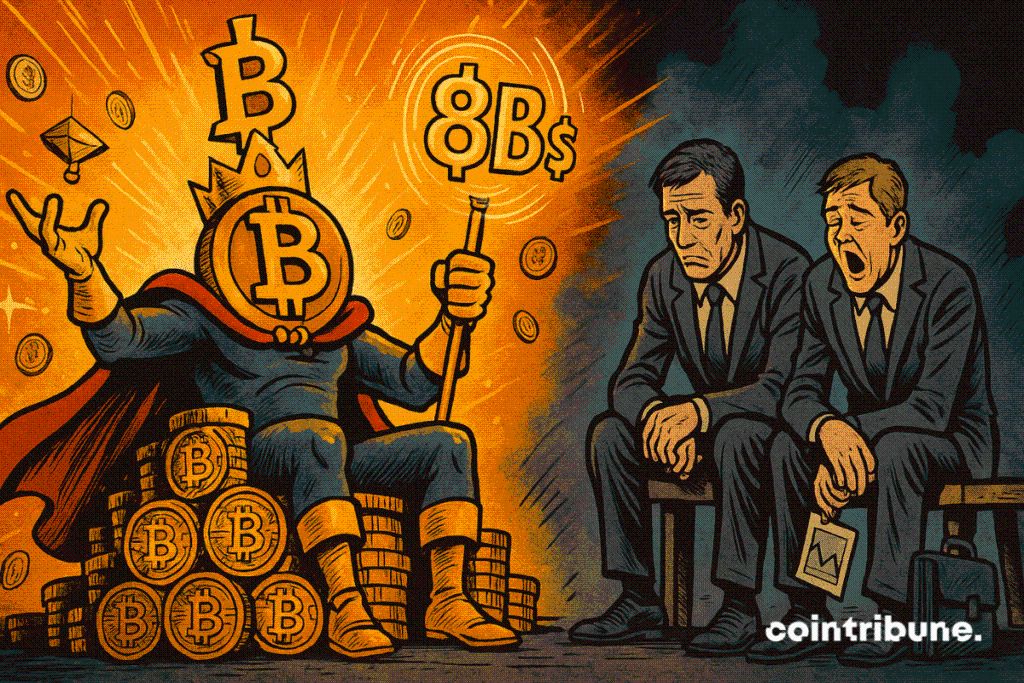Bitcoin’s Technical Rebound Stalls As ETF Pause
In the space of seven days, the realized capitalization of the asset jumped by 8 billion dollars, marking a surge in on-chain activity rarely observed outside periods of extreme tension. This indicator, which measures investments actually committed, suggests a possible bullish return. Yet, despite this structural effervescence, the spot price of bitcoin remains frozen. A dissonance arises between the internal movement of the network and the inertia of external flows.

In brief
- Bitcoin records a $8 billion increase in its realized capitalization in one week, a sign of renewed activity on the blockchain.
- Despite this on-chain momentum, BTC price remains stable, revealing a gap between inflows and market valuation.
- Bullish technical signals, such as rising hashrate or massive mining company investments, confirm the network’s structural strength.
- In parallel, the main demand drivers, ETFs and Strategy, show a clear slowdown in their purchases.
An on-chain recovery masked by price stagnation
Over the past week, bitcoin’s realized capitalization increased by 8 billion dollars, surpassing the $1.1 trillion mark. This indicator, which measures the value of bitcoins at the time of their last transfer, shows an intensification of movements on the network, despite the $1.1 billion liquidation .
According to CryptoQuant data, this increase results from active accumulation, primarily by institutional players. “The on-chain demand is robust”, emphasizes Ki Young Ju, CEO of CryptoQuant, who attributes these flows to Bitcoin treasury firms and ETFs. This renewed activity occurs, however, in a climate still marked by the aftermath of the $19 billion crash in early October.
Several indicators strengthen this reading of an underlying dynamic being rebuilt, despite apparent price stagnation :
- The bitcoin price exceeded $110,000, reflecting a rise in the average cost of recently transferred BTC ;
- Mining specialists are increasing their production capacity : the company American Bitcoin, linked to the Trump family, invested $314 million in 17,280 new ASICs ;
- The network’s global hashrate is rising, which Ki Young Ju interprets as a clear long-term bullish signal ;
- All of this happens in a market where on-chain flows increase, without a proportional price reaction on spot markets.
This gap between fundamentals and valuation reflects a paradox. Despite improving technical and economic structure, bitcoin seems to lack sufficient drivers to trigger a clear bullish dynamic.
Temporary disengagement of ETFs slows the recovery
To understand this blockage, one must look to the two catalysts that largely supported the market over the past months : Bitcoin ETFs and the continuous purchasing strategy of Strategy. These two sources of demand, once strongly bullish, are now in retreat.
“Demand is now mainly driven by ETFs and Strategy, but their purchases have slowed currently”, warns Ki Young Ju in a post published on X. This slowdown in major institutional flows limits, according to him, any attempt at a sustained rebound. As long as these channels do not restart, the market will remain under pressure.
Moreover, the macroeconomic and geopolitical context continues to foster caution. The climate remains marked by uncertainty , despite announcements such as the trade agreement between Presidents Trump and Xi Jinping. On the private side, confidence has not yet returned. Sentiment indicators remain in the so-called “fear” zone since the October crash, which reduces the probability of a demand rebound in the short term.
According to analysts at the Bitfinex exchange, a trend reversal could nonetheless occur if conditions align. They estimate that an inflow of $10 to $15 billion into ETFs, combined with a more accommodative monetary policy from the US Federal Reserve (with two rate cuts in the fourth quarter), could propel BTC to $140,000 as early as November .